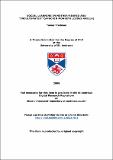Files in this item
Social learning in mother-reared and "enculturated" capuchin monkeys
Item metadata
| dc.contributor.advisor | Whiten, Andrew | |
| dc.contributor.author | Fredman, Tamar | |
| dc.coverage.spatial | 229 | en |
| dc.date.accessioned | 2009-04-30T14:00:40Z | |
| dc.date.available | 2009-04-30T14:00:40Z | |
| dc.date.issued | 2008 | |
| dc.identifier.uri | https://hdl.handle.net/10023/681 | |
| dc.description.abstract | This thesis explores social learning in mother-reared and “enculturated” capuchin monkeys (Cebus apella). At the outset a framework for understanding the social influence on learning is discussed, followed by a review of the social and cognitive abilities of capuchin monkeys, establishing the rationale for studying social learning in this species. Studies of wild capuchins suggest an important role for social learning but experiments with captive subjects have generally failed to support this. Some potential reasons for the lack of evidence in experimental settings are given. An example of using the two - method design to test social learning in acquiring behaviour by enculturated subjects is addressed. The results are related to findings with other species tested with a similar apparatus. Before testing mother-reared monkeys, an observational study of the object manipulation and tool-use repertoire of the subjects was carried out in order to facilitate the design of suitable social learning tasks for these monkeys. The first empirical study in Chapter 6 reports results of experiments with the enculturated and mother-reared capuchin monkeys employing the two -action method together with a third control group. The enculturated monkeys exhibited high fidelity copying that included the specific tool use technique witnessed while opening the foraging box. Mother-reared monkeys exhibited fidelity at a lower level, tending only to re-create the results the model had achieved. The second empirical study in Chapter 7 tested whether capuchin monkeys could show cumulative cultural learning manifested in the ability to switch from an established mode of manipulating a dipping box to a complex yet more advantageous one. Both populations were able to do so. The enculturated monkeys, as in the previous study, showed higher fidelity copying of the model. The last experiment was a preliminary study employing the “do as I do” method which was carried out with four of the enculturated monkeys. It provides suggestive evidence for at least one monkey's understanding of the task. The results of the studies are discussed in relation to previous experimental research as well as to data from capuchin monkeys in nature. The possible role of enculturation in social learning ability is considered. | en |
| dc.format.extent | 3501026 bytes | |
| dc.format.mimetype | application/pdf | |
| dc.language.iso | en | en |
| dc.publisher | University of St Andrews | |
| dc.subject | Capuchin monkeys | en |
| dc.subject | Cebus apella | en |
| dc.subject | Social learning | en |
| dc.subject | Imitation | en |
| dc.subject | Enculturation | en |
| dc.subject | Culture | en |
| dc.subject | Cognition | en |
| dc.subject | Object manipulation | en |
| dc.subject | Tool use | en |
| dc.title | Social learning in mother-reared and "enculturated" capuchin monkeys | en |
| dc.type | Thesis | en |
| dc.type.qualificationlevel | Doctoral | en |
| dc.type.qualificationname | PhD Doctor of Philosophy | en |
| dc.publisher.institution | The University of St Andrews | en |
This item appears in the following Collection(s)
Items in the St Andrews Research Repository are protected by copyright, with all rights reserved, unless otherwise indicated.

